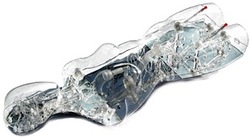Photoelastic techniques allow surgeons to accurately measure the physical stress in vascular models used for surgery simulation

Fig. 1: Nagoya University's Endovascular Evaluator ('EVE') for vascular surgery simulation.
Physical models of blood vessels, or vasculature, allow surgeons to practice their techniques and thereby reduce the risk to patients during actual surgery. It is also useful for monitoring the physical stresses on the model, making it possible to check whether a given procedure would cause damage in a live patient. Carlos Tercero and colleagues at Nagoya University and Fujita Health University have now developed a method for quantifying and reducing the error in measuring these stresses1.
The stress in vascular models is measured by exploiting the photoelastic effect, whereby polarized light passing through the model material -- usually silicone or urethane -- undergoes a phase shift, or retardation, proportional to the stress involved. A material can be classified by its photoelastic coefficient, which relates the force applied to the degree of light retardation.
Using carefully calibrated detection instruments, Tercero and his co-workers measured the photoelastic coefficient of a commercially available urethane with high accuracy. They then constructed a physical vascular model from the urethane and filled it with a fluid that applied pressure to the vessel walls to simulate blood pressure.
The researchers then deformed the model and measured the stress via the retardation of transmitted polarized light while at the same time observing the deformation of the simulated blood vessels by camera. By comparing the stress calculated from polarization and observed displacement, the researchers were able to calculate the error inherent in the polarization measurement method.
The data showed that the photoelastic stress measurement produced an average error of only 3.9% when the simulated blood pressure was between 60 and 189 millimeters of mercury. However, the error rose sharply when the pressure dropped, reaching more than 40% at 40 millimeters. The researchers attribute this error to the assumption of a cylindrical vessel geometry in the numerical model used to calculate stress -- a geometry that can only be maintained under high blood pressure. In addition, the stress decreased as blood pressure dropped, making it harder to measure.
The calibration technique used by the research team was instrumental in obtaining the low error during normal, high-pressure measurements, and should aid the development and use of tools for intravascular treatment, including catheters, guide wires, stents and coils. It may also be useful for robotic surgery.
This work contributes to the development of Nagoya University's vascular surgery simulator (Fig. 1). "We are intending to integrate this new sensing technology into the in vitro simulation environment provided by our Endovascular Evaluator, which we call 'EVE'," says Tercero.
Affiliated Researchers
The Nagoya University affiliated researchers mentioned in this highlight are from the Education and Research of Micro-nano Mechatronics GCOE program
Reference
Tercero, C.R., Ikeda, S., Matsushima, M., Fukuda, T. & Negoro, M. Photoelastic stress analysis error quantification in vasculature models for robot feedback control. IEEE/ASME Transactions on Mechatronics 15, 520-526 (2010) | article